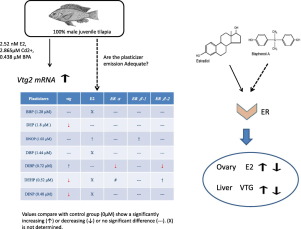当前位置:
X-MOL 学术
›
Comp. Biochem. Physiol. C Toxicol. Pharmacol.
›
论文详情
Our official English website, www.x-mol.net, welcomes your
feedback! (Note: you will need to create a separate account there.)
Changes in vitellogenin and estrogen receptor expression and 17β-estradiol concentration in male juvenile tilapia can be used to evaluate endocrine-disrupting chemicals.
Comparative Biochemistry and Physiology C: Toxicology & Pharmacology ( IF 3.9 ) Pub Date : 2019-12-06 , DOI: 10.1016/j.cbpc.2019.108682 Jung-Ren Chen , Su Mei Wu , Shu Chuan Tsai , Fang-Chun Hsien , Chieh Ting Huang
Comparative Biochemistry and Physiology C: Toxicology & Pharmacology ( IF 3.9 ) Pub Date : 2019-12-06 , DOI: 10.1016/j.cbpc.2019.108682 Jung-Ren Chen , Su Mei Wu , Shu Chuan Tsai , Fang-Chun Hsien , Chieh Ting Huang

|
The effects of endocrine disruption with respect to potential human toxicities have been extensively evaluated to date. However, the standard testing methods used have not always taken the most pertinent approach. In this study, we used juvenile male tilapia (Oreochromis niloticus) as an animal model to test for endocrine disruption by chemicals. We measured 17β-estradiol (E2) concentrations, and the mRNA relative expression ratio (RER; treatment/control) of vitellogenin (vtg2) and estrogen receptors (ERs) to assess whether the effluent concentration of selected plasticizers disrupt E2 function in fish. We found that the vtg2 RER was significantly increased after exposure to 2.52 nM E2 for 5 days, 0.438 μM of bisphenol A (BPA) for 7 days, or 2.865 μM Cd2+ for 7 days. These data support vtg2 transcript level as a sensitive biomarker to evaluate contamination of water by endocrine disrupting chemicals (EDCs). However, vtg2 expression did not respond to fluctuations of E2 concentrations in the tilapia juveniles exposed to selected plasticizers. However, the RER of three types of ERs appeared to change dramatically upon exposure to plasticizers. ERα significantly increased, but ERβ2 decreased with 3.6 μM DEP exposure. Both ERα and ERβ2 decreased significantly after 1.44 μM DIBP exposure. We suggest that changes of vtg2 mRNA RER, E2 levels and ERs mRNA expression should be taken into consideration at the same time to determine if chemical contaminants in the water are endocrine disrupters.
中文翻译:

雄性罗非鱼中卵黄蛋白原和雌激素受体表达的变化以及17β-雌二醇浓度的变化可用于评估破坏内分泌的化学物质。
迄今为止,已经广泛评估了内分泌干扰对潜在的人类毒性的影响。但是,所使用的标准测试方法并不总是采用最相关的方法。在这项研究中,我们使用少年雄性罗非鱼(Oreochromis niloticus)作为动物模型来测试化学物质对内分泌的破坏。我们测量了17β-雌二醇(E2)的浓度,以及卵黄蛋白原(vtg2)和雌激素受体(ERs)的mRNA相对表达比(RER;处理/对照),以评估所选增塑剂的废水浓度是否破坏了鱼类的E2功能。我们发现vtg2 RER在暴露于2.52 nM E2 5天,0.438μM双酚A(BPA)7天或2.865μMCd2 + 7天后显着增加。这些数据支持vtg2转录水平作为一种敏感的生物标志物,用于评估内分泌干扰物(EDC)对水的污染。但是,vtg2表达对暴露于选定增塑剂的罗非鱼幼鱼中E2浓度的波动没有反应。但是,三种类型的ER的RER在暴露于增塑剂后似乎发生了巨大变化。ERα显着增加,但随着3.6μMDEP暴露,ERβ2减少。在暴露1.44μMDIBP后,ERα和ERβ2均显着降低。我们建议应同时考虑vtg2 mRNA RER,E2水平和ERs mRNA表达的变化,以确定水中的化学污染物是否是内分泌干扰物。vtg2表达对暴露于选定增塑剂的罗非鱼幼鱼中E2浓度的波动没有反应。但是,三种类型的ER的RER在暴露于增塑剂后似乎发生了巨大变化。ERα显着增加,但随着3.6μMDEP暴露,ERβ2减少。在暴露1.44μMDIBP后,ERα和ERβ2均显着降低。我们建议应同时考虑vtg2 mRNA RER,E2水平和ERs mRNA表达的变化,以确定水中的化学污染物是否是内分泌干扰物。vtg2表达对暴露于选定增塑剂的罗非鱼幼鱼中E2浓度的波动没有反应。但是,三种类型的ER的RER在暴露于增塑剂后似乎发生了巨大变化。ERα显着增加,但随着3.6μMDEP暴露,ERβ2减少。在暴露1.44μMDIBP后,ERα和ERβ2均显着下降。我们建议应同时考虑vtg2 mRNA RER,E2水平和ERs mRNA表达的变化,以确定水中的化学污染物是否是内分泌干扰物。在暴露1.44μMDIBP后,ERα和ERβ2均显着下降。我们建议应同时考虑vtg2 mRNA RER,E2水平和ERs mRNA表达的变化,以确定水中的化学污染物是否是内分泌干扰物。在暴露1.44μMDIBP后,ERα和ERβ2均显着下降。我们建议应同时考虑vtg2 mRNA RER,E2水平和ERs mRNA表达的变化,以确定水中的化学污染物是否是内分泌干扰物。
更新日期:2019-12-07
中文翻译:

雄性罗非鱼中卵黄蛋白原和雌激素受体表达的变化以及17β-雌二醇浓度的变化可用于评估破坏内分泌的化学物质。
迄今为止,已经广泛评估了内分泌干扰对潜在的人类毒性的影响。但是,所使用的标准测试方法并不总是采用最相关的方法。在这项研究中,我们使用少年雄性罗非鱼(Oreochromis niloticus)作为动物模型来测试化学物质对内分泌的破坏。我们测量了17β-雌二醇(E2)的浓度,以及卵黄蛋白原(vtg2)和雌激素受体(ERs)的mRNA相对表达比(RER;处理/对照),以评估所选增塑剂的废水浓度是否破坏了鱼类的E2功能。我们发现vtg2 RER在暴露于2.52 nM E2 5天,0.438μM双酚A(BPA)7天或2.865μMCd2 + 7天后显着增加。这些数据支持vtg2转录水平作为一种敏感的生物标志物,用于评估内分泌干扰物(EDC)对水的污染。但是,vtg2表达对暴露于选定增塑剂的罗非鱼幼鱼中E2浓度的波动没有反应。但是,三种类型的ER的RER在暴露于增塑剂后似乎发生了巨大变化。ERα显着增加,但随着3.6μMDEP暴露,ERβ2减少。在暴露1.44μMDIBP后,ERα和ERβ2均显着降低。我们建议应同时考虑vtg2 mRNA RER,E2水平和ERs mRNA表达的变化,以确定水中的化学污染物是否是内分泌干扰物。vtg2表达对暴露于选定增塑剂的罗非鱼幼鱼中E2浓度的波动没有反应。但是,三种类型的ER的RER在暴露于增塑剂后似乎发生了巨大变化。ERα显着增加,但随着3.6μMDEP暴露,ERβ2减少。在暴露1.44μMDIBP后,ERα和ERβ2均显着降低。我们建议应同时考虑vtg2 mRNA RER,E2水平和ERs mRNA表达的变化,以确定水中的化学污染物是否是内分泌干扰物。vtg2表达对暴露于选定增塑剂的罗非鱼幼鱼中E2浓度的波动没有反应。但是,三种类型的ER的RER在暴露于增塑剂后似乎发生了巨大变化。ERα显着增加,但随着3.6μMDEP暴露,ERβ2减少。在暴露1.44μMDIBP后,ERα和ERβ2均显着下降。我们建议应同时考虑vtg2 mRNA RER,E2水平和ERs mRNA表达的变化,以确定水中的化学污染物是否是内分泌干扰物。在暴露1.44μMDIBP后,ERα和ERβ2均显着下降。我们建议应同时考虑vtg2 mRNA RER,E2水平和ERs mRNA表达的变化,以确定水中的化学污染物是否是内分泌干扰物。在暴露1.44μMDIBP后,ERα和ERβ2均显着下降。我们建议应同时考虑vtg2 mRNA RER,E2水平和ERs mRNA表达的变化,以确定水中的化学污染物是否是内分泌干扰物。











































 京公网安备 11010802027423号
京公网安备 11010802027423号